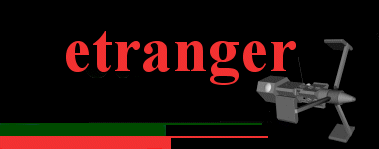
Martel Class Starfighter
By Bryn Monnery and Laurent Esmiol
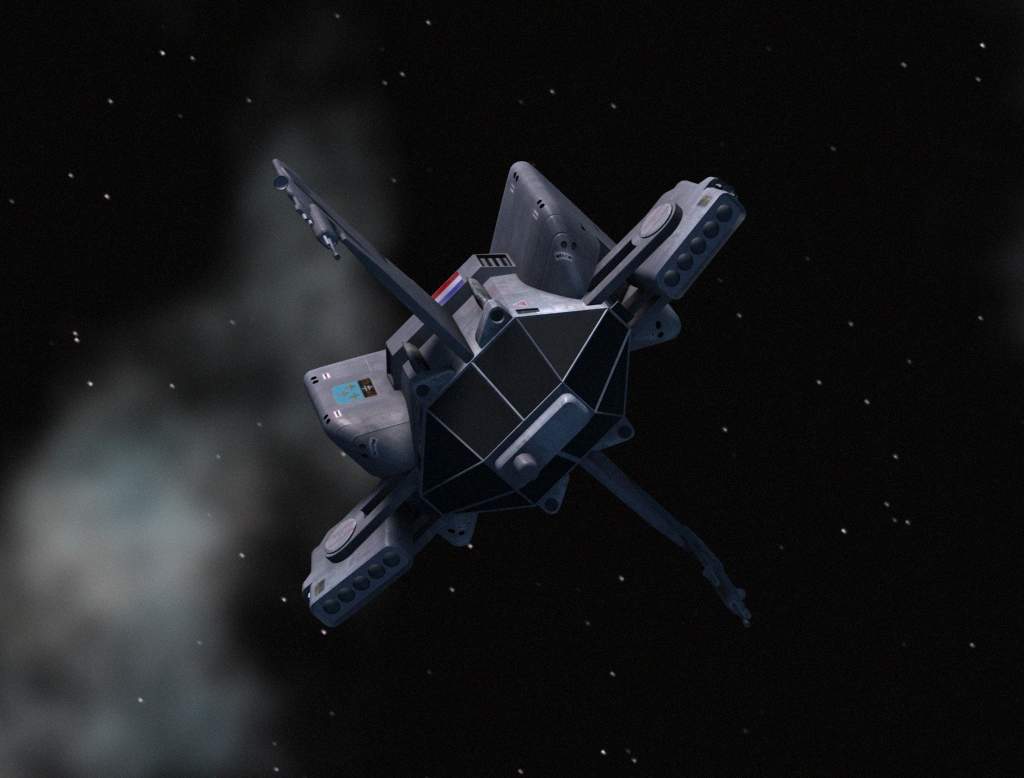
| Above:
Rare footage of a Martel of
1/3 Escadron 'Ile-de-France' on operations in the
Kimanjano system in December 2301. This often
misidentified unit played a key role in the defence of
the system. (MSIF Media Operations.) Introduction The Martel is a state of the art starfighter, and is present in the French and British Orders of Battle in considerable quantity. It has been blooded in battles from the Central Asian War and War of German Reunification through to the Kafer War and has performed excellently throughout. The Martel is truly a fighter without equal. Acknowledgements This article is based on the Martel class fighter described in GDW's Star Cruiser. Feedback from D Hebditch. Narrative "Alert! Alert!" the klaxons screamed, startling Ensign Henri Rochambeau from his drowsing. “All hands man your battle stations, pilots to your ships." Girard, the duty controller cut in coolly on the intercom, "we’ve lost a Sentinel, enemy ships are coming in. Prepare for launch and intercept.”. Henri struggled to clear his head, for a week now while the troops on the ground slowly liberated Kimanjano the fleet had secured the edge of the system from possible counter-attacks. The fighters of the flagship DeGaulle had been held on long, boring quick reaction alerts, now they were needed. The 6 Martels of 2/1 ECSE were powered up and ready to go at a couple of minutes notice. His ship “Serre” was wingman to “Épée” his pilot was already half way through his launch checklist. “Sir we’ve got an immediate launch code, enemy in sight,” Jacques told him as Henri adjusted his G-Web and brought up his systems, chagrined to be so far behind. Jacques started the engines, got green across the board. Épée launched, Serre followed. “Serre free and flying.” Henri told the controllers on the DeGaulle, “Copy that, follow Épée out, form a skirmish line 15 spatiales ahead of the line”. Henri checked his readouts, DeGaulle had lit up screens and was opening missile bays, the rest of the squadron moving to support her. The Kafers must be in range, having slipped through the patrols and there they were. 2 Alphas and 2 Epsilons, escorting a dozen Oscars, a troop train bringing either a brigade of troops or supplies to Kimanjano. The targeting graphic showed 8 Kafer fighters coming fast in the vanguard, they met their French opponents in the middle of the battle. “Serre this is Épée, we’re going for their fighters, pop a pair of nukes as we come to contact, take Targets 3 and 4.” The target designators coming up on his VHUD “I’ll take 1 and 2, then it’s a furball, if we get the chance we’ll break through and go for the transports.” “Roger that Épée”, his target display told him he was in range and he pulled the trigger... |
| Development The Martel began life in 2282 as a purely French project. At the time French companies had developed materials technology to new heights, allowing for beanstalk construction but also allowing spaceships to be very heavily armoured. However their drive technologies were less advanced and their ships were underpowered when compared with other designs. The prototype Martels were found to be good only for the point defence of targets, lacking the speed to engage other fighters or warships effectively. It look for a while if the project was going nowhere. Across the Channel the British had just introduced the Wellington, a flawed design that had divided the RSN. Although acceptable as a planetary defence fighter for the colonies it was unsuitable for the deep space role and other options were being looked at. At the time British MHD turbines and stardrives were significantly better than their French counterparts. A deal was reached between these two old allies and Rolls-Royce power systems installed in one of the prototype Martels. The results were almost as startling as the 20th Century combination of American airframe and British powerplant that produced the P-51 Mustang. In spite of some teething trouble the new Martel was everything the designers hoped she would be. An Anglo-French agreement was signed in Paris in 2283, where the French would receive 10 powerplant systems from Rolls-Royce and then begin licensed production of these powerplants. In return the British could produce their own variant of the Martel, to be known as the Harrier. Although the individual components for the Martel were produced rapidly, systems integration was a problem. A major difficulty was that the French built navigation systems and the British stardrive could not talk to each other reliably. This and other similar problems kept the ship experimental until 2284, as both governments wanting their own software systems to dominate. However, with the demands of the Central Asian War, the need for the ships became acute and the French eventually accepted the solution proposed by Rolls-Royce's Merlin Labs. The first complete working starframe was ready in late 2285, and the French formed their first squadron in the following year. The French yards at New Guyana (in orbit over Guyana) started turning out these fighters at a rapid rate, 1 a month, allowing 2 escadrons to be formed a year. The British followed more slowly with the first Harrier squadron becoming fully operational in 2289. Both nations found they had an exceptional fighter, surpassing their initial estimates. Built entirely for space, the vessel wasn’t streamlined but was incredibly responsive. Its UTES allows for a heavy armament on a small frame and the submunitions gave it an incredible punch. |
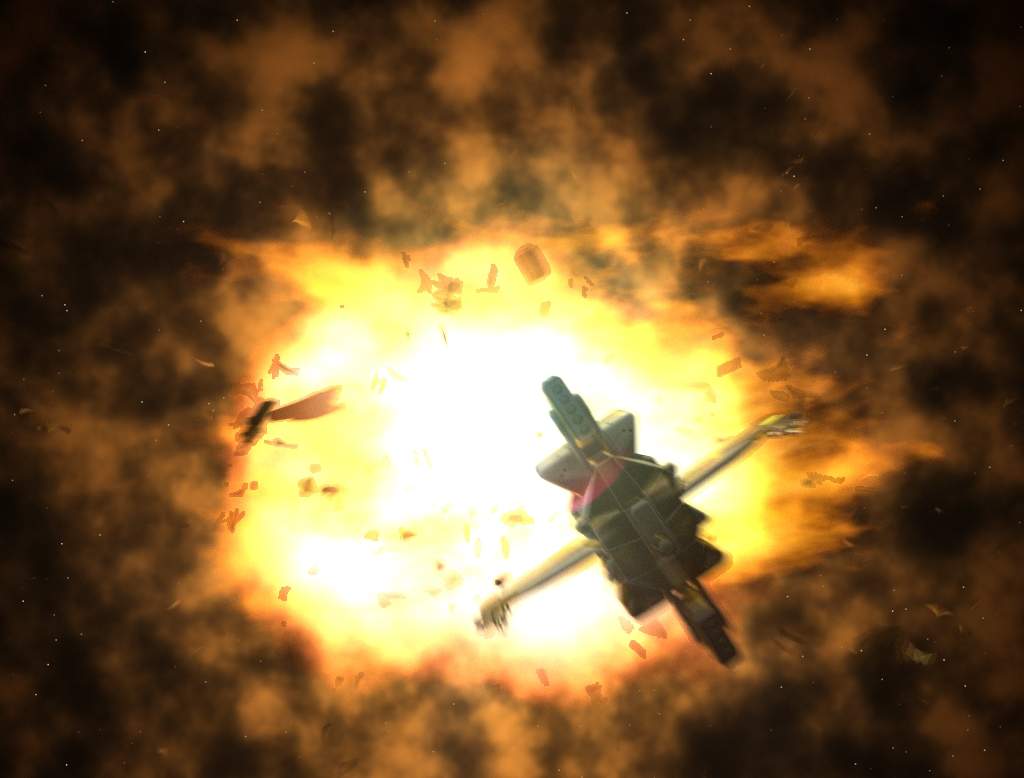
| Above:
"Missiles! Missiles!" Cleaned
VHUD display footage of the last seconds of No 3 Fighter
'Aigle De Grève', 1/4 Escadron 'La Fayette' during
fighting in the Kimanjano system January 2303. (MSIF
Media Ops.)
The Martel has a heavily armoured transparent cockpit which allows a wide field of view. In stutterwarp combat it is of course impossible to make visual contact with a target light seconds away. However, the entire view is one large VHUD. Contacts are displayed in brackets, with range, vector and other information arrayed around it. The cockpit area has 2 decks. The commander sits in the upper deck cockpit, and the pilot in the lower cockpit. The workstations are of course virtual, and fully customisable. The ships functions may be accessed by either crewman, and the fighter can be flown by a single person. However this creates problems with the weapons systems, as no one can direct the target systems effectively, and the guns can only fire directly ahead in the forward arcs. Normally the commander's cockpit controls the electronics systems. These systems are the UTES, sensors, communications and electronic countermeasures suites. The pilot's cockpit controls the navigation and helm systems, the power systems and the weapons. The pilots are dressed in a heavy duty version of the standard shipsuit. It is a mechanical counterpressure spacesuit, fitted with a helmet and gloves. It allows sustained life in space for a short time, although they will freeze quickly. The standard ejection procedure is for the entire cockpit section to explosively eject from the ship body, acting as a liferaft for several days. The cockpit area includes the bunks, which are extremely small, and basically a sleeping bag hung up on the wall, and a small chemical toilet fitting for their suits (which collect waste in hip pouches). Food is provided in self heating ship rations, water comes from a 30 litre tank and may be heated by a microwave cooking system. While normally rated for 20 hours work, with the drive dialled back the ship may make patrols for 2.5 days, and may in fact cross the gulf between stars under their own power, although this is not often used. |
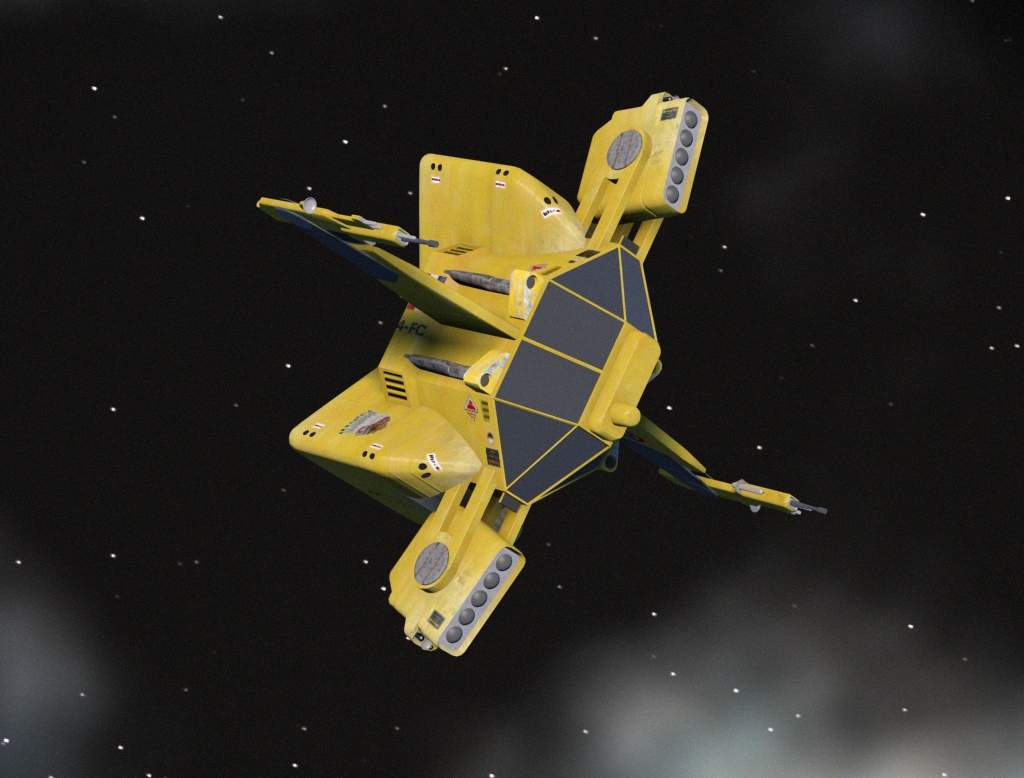
| Above: A
pre-war shot of a Martel of the famous 1/4 Escadron 'La
Fayette' operating on the French Arm. The Lafayette
retained this distinctive yellow colour scheme long after
other units moved to Blue-Grey. (Space Forces Monthly)
"Observe that the American FS-17 class fighter has no all aspect capability, and is considerably less manoeuvrable than your fighters. In any kind of match up you will have a considerable advantage by pressing on their six. Should they jump you, you can always pop a submunition. Watch out for the latest variant, they've taken a leaf from our book and added a Big Clip, giving an all aspect capability and a much improved performance." - Lecture at the MSIF Fighter School on comparative fighter tactics French fighter doctrine is focused on there being 3 types of fighter with different roles. The Riche and Bonaparte are classed a System Defence Fighters, the Riche patrolling the low risk Core Worlds while the Bonaparte patrols the high risk frontier worlds. The Mistral and Bufer are Strike Fighters, respectively planet and carrier based, and carry missiles forward to deliver strikes against enemy line ships and fighters. The final class is the Martel, the most numerous ship in the MSIF and is an Assault Fighter, tasked with closing and killing enemy ships rather than launching a missile from half a light minute away. It is highly survivable and carries a large complement of submunitions which are capable of crippling and killing even large ships. The Martel is a low profile vessel and is extremely heavily armoured, by far the most armoured human ship. This means it can endure heavy defensive fire and still deliver ordnance on target. It is highly resistant to missiles. A SIM-14 only has a 0.8% chance of downing a Martel, she can take fire which would smash a large cruiser to pieces. However, the surface fixtures will be destroyed well before this, and the fighter forced to return to base. Her target acquisition system is superior to most vessels this size, with a Darlan S-2280 passive array capable of detecting a Kafer Improved Alpha upto 34 light seconds away, while her active scan radar can make target locks upto 50 light seconds away. However, the lasers must be powered down for this. The weapons systems consist of 2 Guiscard L-98 lasers in jack turrets, and 2 LL-2 submunitions launchers. These weapons are superior to the American and German variants, as they can launch their entire ammunition clip in a single salvo. All these are controlled by a single TTA, controlled by the Captain, although the Pilot has control of the actual trigger. Martel tactics are not sophisticated. Mistrals and Bufers may stalk targets, launching attacks from half a light minute away. The Martel has no long range weapons, and instead relies on its low profile and heavy armour to keep it functioning while under a barrage of fire, using the lasers and submunitions to maximum effect. The main complaint was that the ship wasn’t fast enough to keep up with some capital vessels, fortunately the Kafer vessels which have been their main opponents in recent years are slower than the Martel. The Martel is not a tantalum intensive design, and uses no missiles so imposes much less strain on the massive production base of the French Empire, which produces fully 3 times more war material than America or Germany, and production has recently stabilised back at wartime levels of a fighter off the lines every month, huge compared to other powers. Mission Profiles Patrol Grav Sensors cannot localise signatures and dispersion means that DSS is also inaccurate. Making a contact beyond 60 light seconds (30 hexes) is nearly impossible. Some refer to this as the space warfare equivalent of the radar horizon. To extend its reach a ship must put sensors away from their hull and there are two ways of doing this. The first is to put a sensor drone out, but the lag in communications means that this is only viable for closer ranges. Fighters can massively extend the reach of a ship, patrolling well out from the ship and providing early warning. If standing orders allow for engagement this is called a Combat Patrol. Screen Screening involves a group of fighters keeping the enemy away from other ships. These missions generally involve defending discharging or fleeing ships. The other screening mission involves combat between both sides fighters between the main ships. Strike A formed and planned attack on an enemy ship or base. Generally Strikes are conducted by the larger carrier vessels, which can put dozens of ships into action and the strike. Escort The final task fighters have is escort. Fighters have longish ranges and the Martel can escort a vessel almost a fair way towards the FTL cut-off. Currently Martels of 11e GCS are tasked with escorting French military and civilian ships out of the solar system. One of their squadrons is based in the asteroid belt and another Mars orbit. They provide cover for incoming ships. |
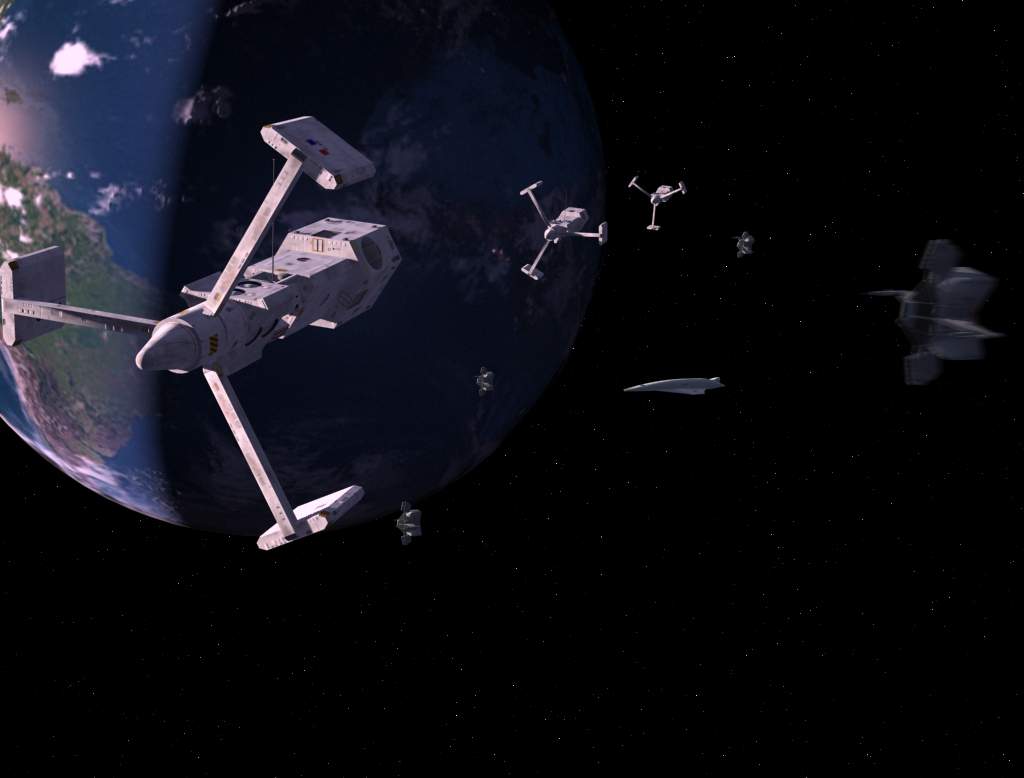
| Above: The
Imperial Fleet Review, 14th July 2300. Ruffin's personal
shuttle, flanked by 4 Martels of Escadron 1/1 'Picardie'
inspects the fleet in Earth Orbit. The 3 cruisers
pictured are (from the front) Jean Bart,
Montcalm and George
Leygues. (AFP)
The first combat use of the Martel was a skirmish against a Manchu frigate near the Jovian system during the Central Asian War. 2 Martels attacked the Luhu which found its missiles completely ineffective as the Martels screamed in, smashing it with submunitions. The Luhus hull failed under the onslaught and she was lost with all hands. This incident showed up the shifting role of the fighter. The Martel, heavily armoured and armed with the new submunitions weapons developed by Argentina during the 3rd Rio Plata War and copied around the world was a completely different breed from the fighters which preceded her. Much like the torpedo boats of almost 400 years earlier, they gave a small craft the ability to inflict damage on much larger, more expensive ships. The problem was how to get Martels into combat. Lacking the range to make jumps to other systems, the Martel, while formidable, was a defensive weapon. The immediate solution was the refitting of the larger vessels as Martel carriers. The Battleships Napoleon, Orleans, DeGaulle and Charlemagne were all refitted as to carry Martels, landing the older Gabriel as the new fighters became availible. In the meantime, the Richeleiu, Tallayrand and Sainte Jeanne d’Arc were laid down as Martel carrier ships from the keel up. The Napoleon and Orleans were not to survive the intense last year of the war, which with the perceived failure of raiding tactics, saw the Manchu fleet committing to regular fleet actions. This culminated in the decisive running fight at Barnards Star that finished the Manchurian fleet as a force that could influence the outcome of the war. The Napoleon was mined in the Tirane system, and set upon by the Manchu squadron which laid the mine. The Orleans suffered an internal explosion which destroyed her, apparently a nuclear warhead detonating in the ship's magazine. Speculation was rife that this was a Manchu sabotage plot, but the truth has never been established either way. The Martels were excellent fighters, but were not available in quantity, and so could not be employed en masse. They were too late to change the face of a war which had already been decided on Earth. During the final months of the war, Martels made a spectacular feat, warping between star systems without a carrier. This was a difficult operation, and the range was limited enough to make it one way trip. However the sudden arrival of a pair of fast fighters in-system caused havoc, and they could always be refuelled in space to return. Ultimately though it was not space that the war was decided on Earth. The French kept their supply lines open, cut the Manchu lines, but failed due to Manchuria having no dependence on the colonies. The rebel colony of Elysia was kept under close siege until the Manchurians managed to break the blockade in the late phase of the Central Asian War. The French fell back to a far blockade position as the Elysian defences were sufficient to hold off the squadron there. In 2291 the French mounted a major offensive at Joi. A battlegroup including a Cruiser assaulted the planet's orbital space and was opposed by the whole of the Force Spatial d'Elysia, a mixed bag of privateers, mercenaries and rebels. The Elysian frigates Liberté and Peuple Souverain were engaged by the DeGrasse while other famous FSE vessels like the destroyer Grognard, the Frigates Défit, Rouge, and their ancient Cruiser Verte were engaged by other French units. With the French squadron were several Martels, based off the Cuirassés. The Martels assaulted several vessels and destroyed the Verte amongst others. Ultimately the French fleet suffered heavy losses and were hampered by being forced to run their supplies through bases at Henry's Star and soon withdrew several warships out of the system for repairs. This enabled the Elysians to destroy vulnerable forward bases, further hampering French efforts. With the situation on the ground firmly in the favour of the rebels and the German crisis looming, the French finally withdrew the blockade and abandoned the struggle for Elysia, recognising its independence. The Martels and other warships returned to the system and were involved in the post-armistice evacuation of French troops, officials and civilians from Joi. The next actions involving Martels occurred in the Franco-German War against the ex-Bavarian Gustav fighters in one on one combat during a Fleet to Fleet encounter in the Beta Canum system. The Gustav was fast but unarmoured and was easily defeated. The Germans tried to produce a fighter to counter the Martel, the Wespe, but this ultimately failed in this by the requirement to planet base it. Leading to the development of a dedicated German fighter carrier and the refitting of the Bismarcks to carry Wespes. One of the most notable of these actions was the attack on the Fighter School at Ganymede. The attacking force consisted of 14 fighters, a mix of Gustavs and Udets, plus some old Siegfieds (which are now withdrawn). While the defenders consisted of the training wing of the school, 6 3 fighter squadrons, one for each type of Starfighter in the MSIF arsenal at that time (including the now retired Gabriel). While suffering massive casualties (the school took 2 years to recover), the raid was defeated and within hours fleet units from Earth, including the famed Gloire were searching for the German carrier ship. Throughout this war the Martel proved so effective that German High Command ordered their ships to avoid combat with them. So successful that both France and Britain decided to produce dedicated fighter carriers with 54 and 30 fighters respectively. There were 6 Martels based on the Sainte Jeanne d’Arc when the Kafers invaded Aurore, and they covered the retreat of the fleet after the destruction of their flagship, before the 2 survivors warped to Hochbaden. The returning Tallayrand had a squadron of 8 onboard (their own squadron 3/1 and the 2 survivors of 1/1), and they spearheaded the assault on the Kafers, 5 being destroyed in the fighting. Time and again the Martels proved their worth through their shear survivability, distracting the Kafers from more vulnerable warships. When the Invasion occurred 4 years later, the Tallayrand's fighters had not been replaced, as the demand for fighters for the Joffre was so great. At 2nd Hochbaden, the Kafers showed they had learnt from the previous fightings and hit the Martels with missile barrages destroying them. Present on all French carriers during the War, the Martel was particularly noted for their stubborn resistance at Kimanjano, holding up the Kafer fleet for 3 months with a mere 3 groups of fighters. This allowed time for the reinforcement of Queen Alice's Star and the high water mark of the Kafer invasion. The two fighters carriers at QAS and the British, French and American dreadnoughts put 120 fighters into the battle, by far the biggest fighter concentration ever seen. The majority of these were Martels, the Kafers were overwhelmed by the waves of fighters and only 1/3rd of their fleet escaped back up arm. |
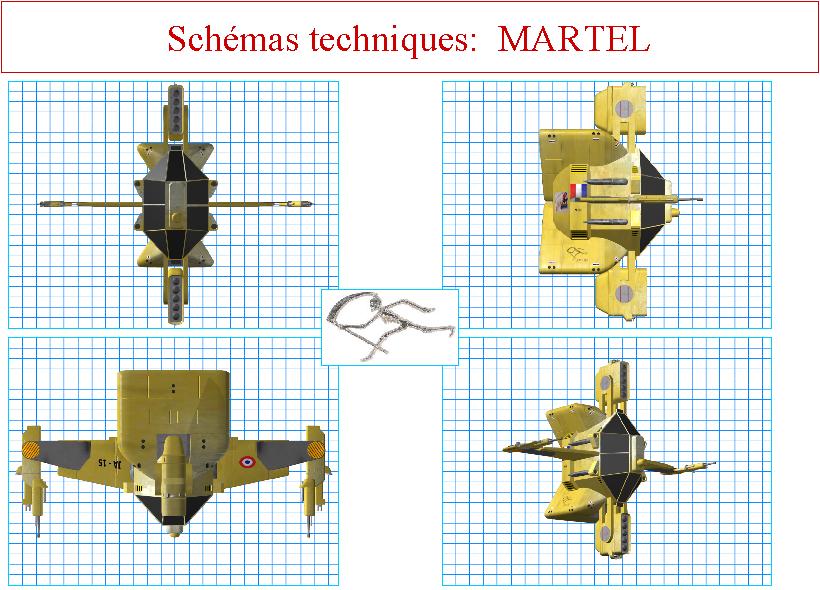
| Above:
Technical schematics of the Martel.
French Martel Class Fighter
Performance
Ship Status Sheet
|
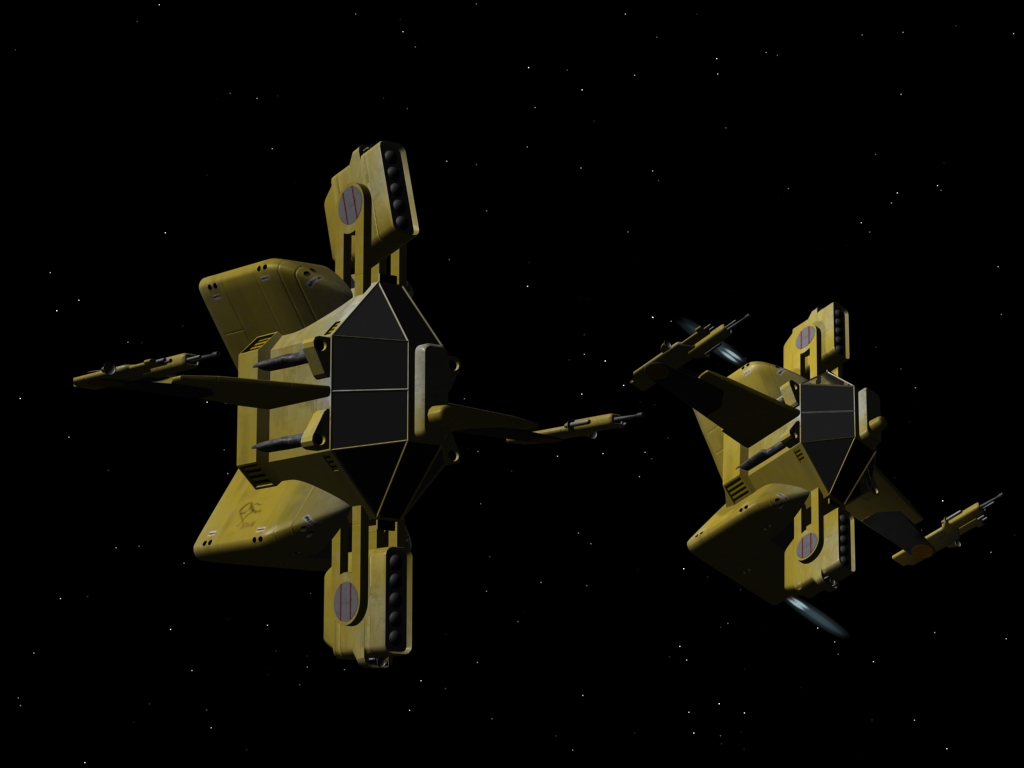
| Above: A pair
of Martels of the 2/4 Escadron 'Touraine' on deployment
to BCV during the Summer of 2297. (MSIF Media Ops).
"You are here because you think you have what it takes to be a fighter pilot. You are almost certainly wrong. 90% of you aren't even worth the price of shipping to orbit, and we will find you out. For those who are left, you have years of hard training in zero gravity, it will permanently warp you. Space fighter pilots have an average life expectancy of 60 years, 40 short of the norm, and much of this is due to the health problems. If you are skilful and adapt, then maybe you can hope for an honourable death in battle, rather than end up an arthritic wreck." - Maitre Principal Antoine Lagaillard introductory talk to class 98.01, Guynemer Aerodrome All French fighter squadrons (escadron) have 6 fighters, and have a higher organisation in the starfighter group (Groupe de Chasse Spatiale), sometimes called an Escadre (Wing). The squadron is broken down to 3 flights (of 2 fighters). A GCS is generally 3 squadrons, but some stations are slightly different. Currently, the French have the following Martel units: 1e GCSE - Battleships
3/1 ECSE is understrength due to combat at Aurore, and replacement hulls have been assigned to the Joffre instead. 3e FCS - Kimanjano
4e GCS - Kimanjano
The 1/4 Escadron is mostly manned by American volunteers on secondment from the USSF but also includes some Bavarian ex-patriots. Misunderstanding of this has led to some sources wrongly believing that the whole of the Martel force based at Kimanjano being a part of the Légion Étrangère. For their part the MSIF laughs at the idea they would hand over 50 of their finest fighters over to foreign pilots. 6e GCSE - IFS Joffre
7e GCS - Kimanjano
9e FCS - Training Unit at Jupiter
10e GCSE - IFS Joffre
11e GCS - Earth
16e GCSE - Battleships
Above: Various insignia used on Martels. A - squadron insignia of 1/1 'Picardie' the senior MSIF fighter squadron. B - reaper emblem found on the three escadres based at Kimanjano. C - Nose art used on one fighter from 1/4 'La Fayette' D - squadron insignia of 1/4 'La Fayette', based on that used by the WW1 American volunteer squadron that fought for France. Each fighter has a 6 man crew, the Pilots and Commanders fly the ship while the Technician and Controller are left on the carrier or at base. The Pilot is a Ensign or Petty Officer, and has had service of 3-6 years, and is responsible for flying the ship and firing the weapons. Commander is a courtesy title given to the fighter commander who is normally a Lieutenant or Petty Officer of 3-9 years service, he commands the ship and controls the sensor systems. There are generally 2 crews for each vessel. The flight commander is a full Lieutenant of 9-15 years service. The Squadron Commander does not fly, but remains on the Carrier and is a Lieutenant Commander. The Technician is responsible for the immediate maintenance of the fighter, but not the more in depth refit the vessel requires from time to time. The Controller remains on the carrier and is responsible for maintaining communications with the fighter and controlling it in combat. Controllers are selected from their own career stream early on and are usually Petty Officers. Prospective Fighter Crew must attend the MSIF Fighter School on Ganymede after joining the MSIF from any of the academies, whether enlisted or commissioned. They must be in the top 10% percentile for special awareness and g-tolerance in the MSIF (which has already selected for just these factors anyway). The course is 3 years long and there are two intakes every year. Each intake consists of around 100 young hopefuls of whom maybe 50 will graduate, many of the dropouts end up as helm or navigation officers on line ships. The Course starts with 6 months of zero-g orientation, g-endurance and special awareness exercises. At the end of this, many will be found to be totally unsuitable for fighter crew and will transfer out. The next year is spent flying fighters in the simulator and learning the technical details of all fighters in the French arsenal. The next year is spent flying mock combat missions around the Solar system under the supervision of Pilot-Instructors. At this stage the final selection is made, and around 50 young pilots move to the final exercise. The final exercise involves deploying to a carrier vessel and flying independent mock combat missions for six months in different environments. Around half these will graduate as pilots. The fighter pilot will return to the Fighter School after roughly 3 years if found suitable to command a fighter and attend the Junior Fighter Command Course, which is roughly a year long and concludes with commanding trainee pilots in mock combat in the solar system before returning to their unit, if the pilot does not have one, they will gain a commission. If chosen for higher command they will attend the Senior Fighter Command Course, which qualifies them as Flight Commanders. Squadron Command is taken at the Command Academy on Luna, and they will become a staff officer. Group Commanders hold the rank of Commodore, and few will reach this level, but those who do make aspire to an Admiralship. Most career officers will top out at Squadron Command. |
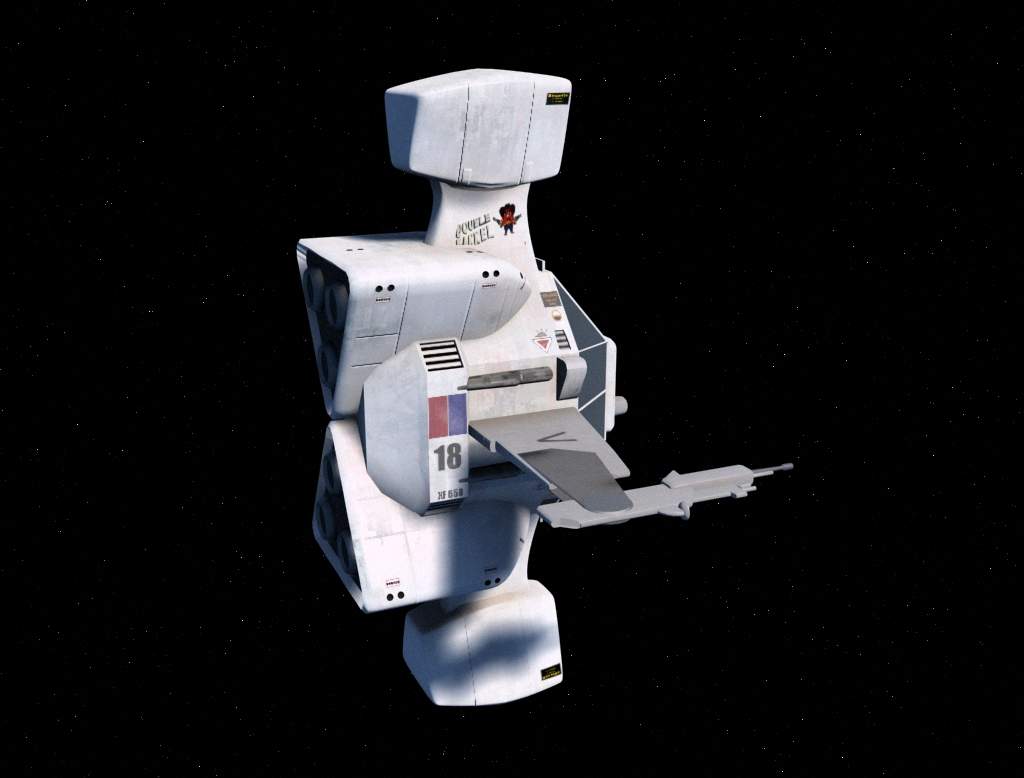
| Above: Harrier 18 of
No. 5 Group on patrol in the Queen Alice's Star system
prior to the Battle of Beowulf. The Deck Code 'V'
identifies this ship as being from 1220 NFS based on HMS
Victory. (Reserve Fleet Joint Media Group.)
The British Harrier was developed from the Martel and is externally almost identical to the Martel, but has a different submunitions fit. It has 2 Marconi launchers, each with 3 rounds doing 5x3 each. The ship is 16 tons heavier due to the heavier weapons load, but the stats are otherwise unaffected. Internally several avionics systems are different from its French counterpart. The British also use a 6 fighter squadron organisation, but the squadrons are not permanently attached to specific groups. Prior to the Invasion most British Harrier were based in the Core with only small numbers on the French Arm. However almost all the British fighters engaged at the Battle of Beowulf were Harriers. The type is the premier weapon system of the RSN Fighter Service and it was Harriers from the Ark Royal that finished Triumphant Destiny's Delta at the Battle of Beowulf.
Performance
Ship Status Sheet
Below: Another shot of Harrier 18 from 1220 NFS. Note the much larger size of the submunition warheads than those used on the Martel. (Reserve Fleet Joint Media Group). |
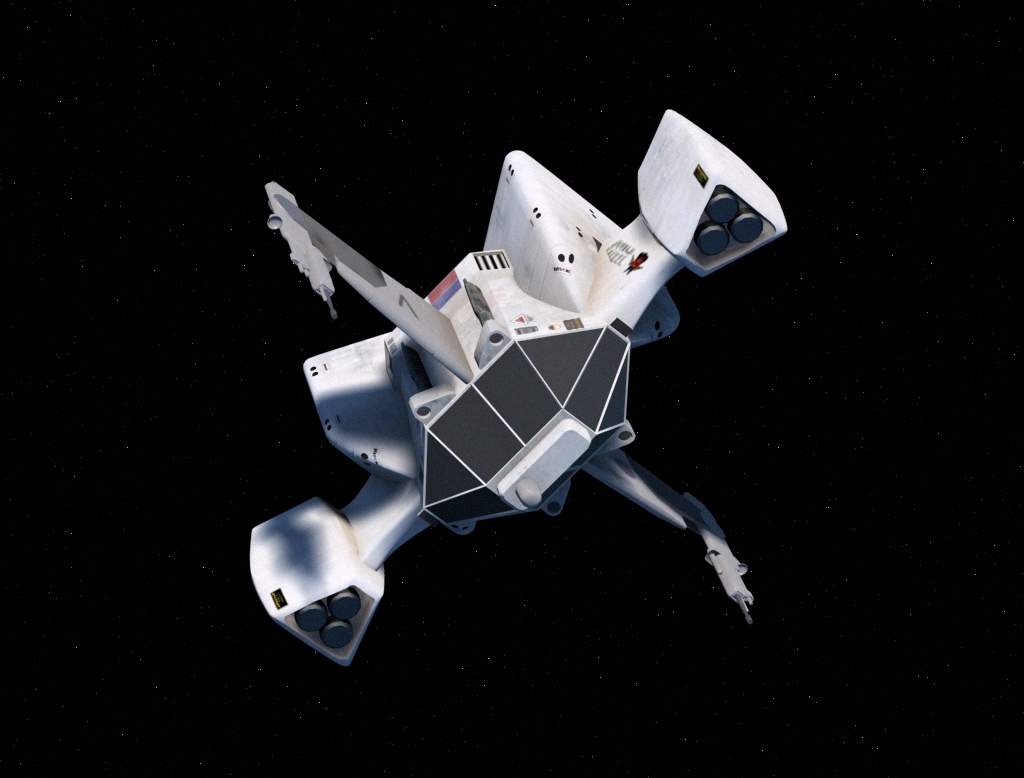
Glossary
|
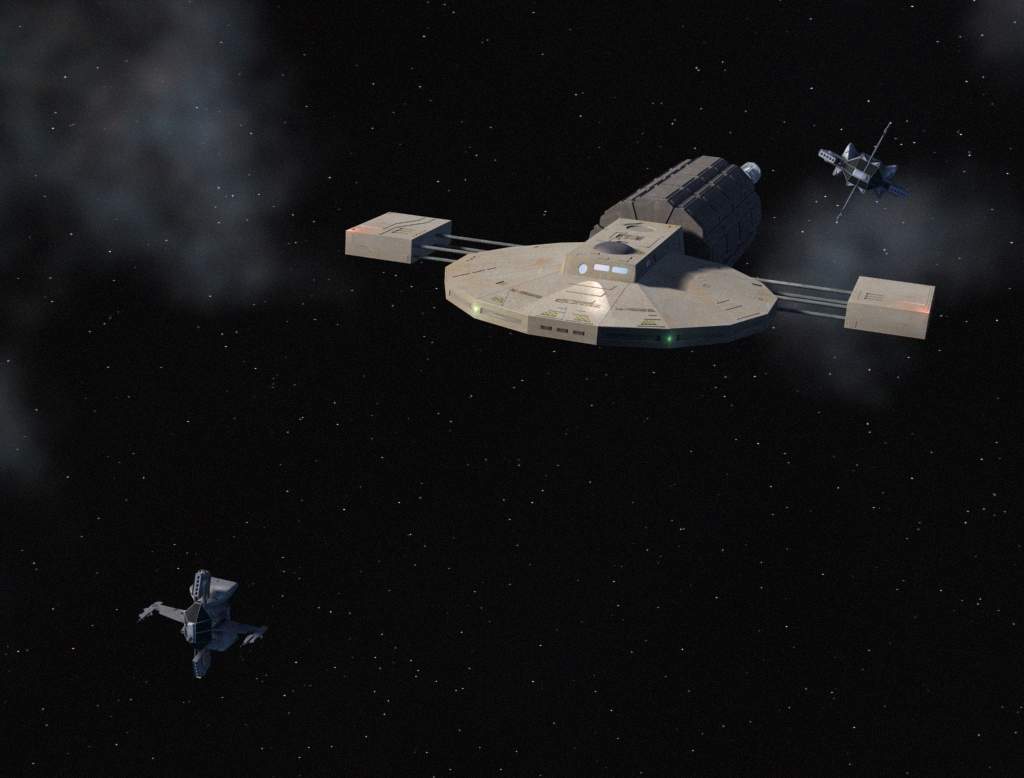
| Above: 2 Martels of
Escadron 3/11 'Corse' escorting the megatransporter Cuivre
(loaded with the heavy equipment of the 2e Division de
Marche Coloniale) into the Kimanjano system during the
Liberation. (MSIF media operations).
Agility and Dogfighting Star Cruiser does not really cater for large furballs in a single hex, concentrating instead on long range combat using missiles. To fill in this gap, use these rules when multiple ships are involved in a furball. Each ship has an agility rating, calculated as follows. Divide TOTAL power plant output by the ships (mass x length) and multiply by 2,500, rounding to the nearest whole number. This is the ships agility rating. For the Martel this is 6, for the Kennedy it is 0 (which nearly all major warships will have). Add the pilots skill to this number and d6. The fighters act in the order of this total, lowest first. They may decide which arc they are firing in, and which arc they are in relative to their opponents. The last to move take precedence, then attacks are made. For example: 3 Martels and 2 Golfs are in a furball. The Martels are all +2 CQ, the Kafers 0. The Agility of the Martel is 6, the Golf is 4. The Martels score 9, 11 and 13, the Golfs 8 and 12. The poor Golf announces he is behind the first Martel, which moves next, overruling the Golf and declaring he is in his six, as does the next Martel. The second Golf decides it is in the other twos six, while the final Martel is pursuing him. Thus the first Golf has no one in his arcs, while the first and second Martels may only fire at this Golf. The remaining Golf may fire at Martel 1 and 2, but not 3. The same rules may be used to dodge missiles. They also have an agility rating. Note that the missile doesn’t have to commit unless it has you in arc, so it’s just buying time until you nail it or it gets a lock.
|